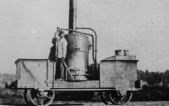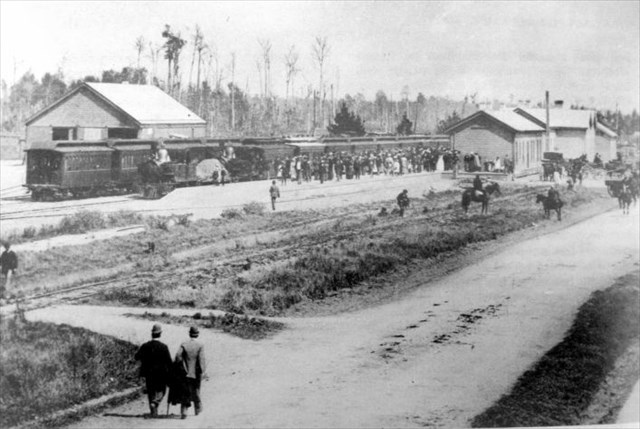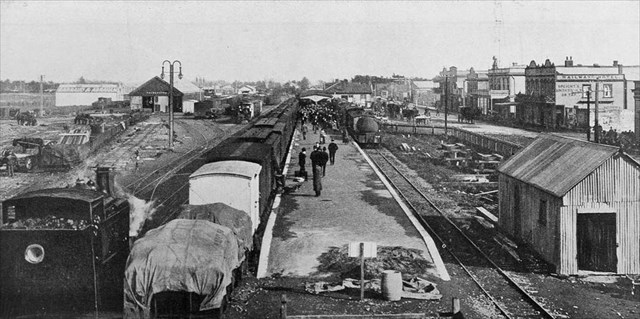Welcome aboard the Foxton-Palmerston tram service to Palmerston! Last stop Awa Puni, next stop Terrace End, end of the line! Services connect here to the Hawkes Bay, next stop Terrace End, and to Wanganui, next stop also Terrace End.
The Town of Palmerston was settled in Te Papaioea, a natural clearing in the middle of dense bush forest. The clearing stretched from what is now Featherston to Ferguson streets, from Cook to Ruahine, about 2000 hectares. It is part of a block of land, from Apiti to Linton, from the Oroua River to the centre of the ranges, that was purchased from the Rangitane in 1864 for £12,000 and auctioned off to settlers in 1866. The new settlement was named after Lord Palmerston who died a year earlier, in 1865, while Prime Minister of Britain. The Post Office adopted the name Palmerston North in 1871 to distinguish it from Palmerston in the South Island, but debate raged on and the final decision on the new town name was not made till 1876. Despite this people still referred to it as Palmerston and it was even shown as this in railway timetables as late as 1909.
Palmerston was a planned town (thus the very linear nature of the streets), planned to take advantage of the excellent timber growing in the forests surrounding it. But this means either putting in a road capable of getting the settlers in and the produce out, or putting in a tramway, through to Foxton and the shipping that stopped there. The tramway was cheaper. In 1871, when Palmerston's population was just 25, construction started for a wooden-rail, horse-drawn tramway to Foxton which was completed just two years later, in 1873. Within a year of completion Palmerston's population had grown to 193 (note that population figures then did not include Māori).
| A steam engine was purchased and used to assist in the completion of the line, however the poor construction quality of the line and the timber rails meant that the engine was too heavy and so the line remained as a horse drawn tramway until upgraded with better foundations and steel rails in 1876. Besides housing construction, the tramway and subsequent railway provided much of the employment, through production of timber from the bush for sleepers and general building, and stone from the gravel pit for the foundation. (Palmerston was actually the second stop, the start of the line |

The first steam engine
Palmerston, 1872
|
being at the town of Terrace End for access to the Government gravel pit there.) After completion the line ran in private hands for eight months, then ownership and operation was handed over to the government.
Palmerston Railway Station was built in the town square in 1876 after the completion of the upgrade to steel rails as part of the Wellington to New Plymouth main trunk line - the Wanganui line was connected just two years later, at which time the pakeha population had exceeded 880. Growth continued so much that in 1883 the rail service was asking for more space in the town square and the newspapers were reporting on complaints about how much space the railyards were taking up already. After the Wellington and Manawatu Railway linked up at Longburn in 1886 (population now 2606, excluding Māori), and the side branch through the gorge to Napier was opened in 1891 (population now 4303), traffic had increased to 1500-2000 rail cars per day and in order to reduce the bottlenecks - the number of level crossings, limited shunting space and undersized station house, space for loading/unloading livestock, ores and other goods - the station and yards were moved 600m south down Main Street, to an area now known as the Railway Land, opposite the Railway Tavern. However this only solved some of the space issues, and a recommendation in 1914 and two Commissions of Enquiry, in 1916 and 1924, recommended that the line be moved to the edge of town. Despite this, construction was not started on the Milson deviation to join at Keith Street and Longburn until 1926. The war, political intrigue and opposition from local business meant that this was not completed until 1959, and then only as a goods service. A measure of the public opposition can be seen from the additional four years it took before the station house was built and passenger traffic was also diverted there. The Awa Puni and Terrace End stations were then closed and all the tracks through the middle of town removed. The gravel pit had been closed for some time and was remade into Fitzroy Park in 1938 then renamed Memorial Park in 1952.
Although most of the evidence has gone, you can still clearly see the rail's right-of-way, beside the main road on the right, as you drive from Palmerston North to Himitangi.

Train for Foxton waiting at the Palmerston stop in The Square, 1878.

Palmerston North Railway Station from Main St, 1904
(The Square is to the left)
 Palmerston North Railway Station and Main Street, 1921
Palmerston North Railway Station and Main Street, 1921
(The Square is behind the photographer)
Today the station is busiest when the occasional steam train comes through. Outside of that there are just two trains per day stopping here.
The cache is a 1L container. FTF gets to FTF a new TB. Good luck!
References:
Cassells, K.R.: "The Foxton and Wanganui Railway", published by the New Zealand Railway and Locomotive Society, 1984.
O'Neill, Garry: "Terrace End", published by The Palmerston North Historical Society, 2009.
Palmerston North City Council: www.pncc.govt.nz/about/history/